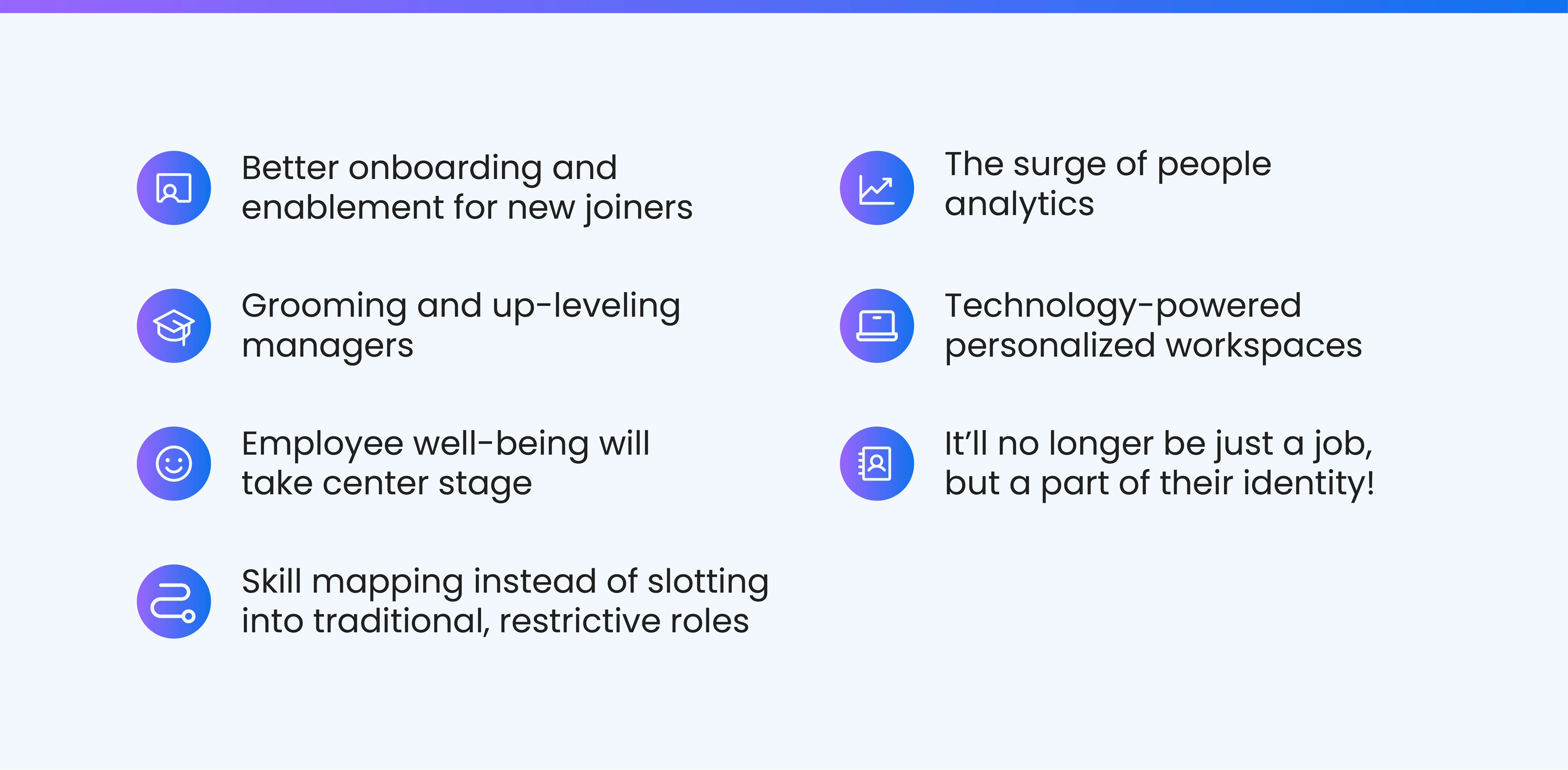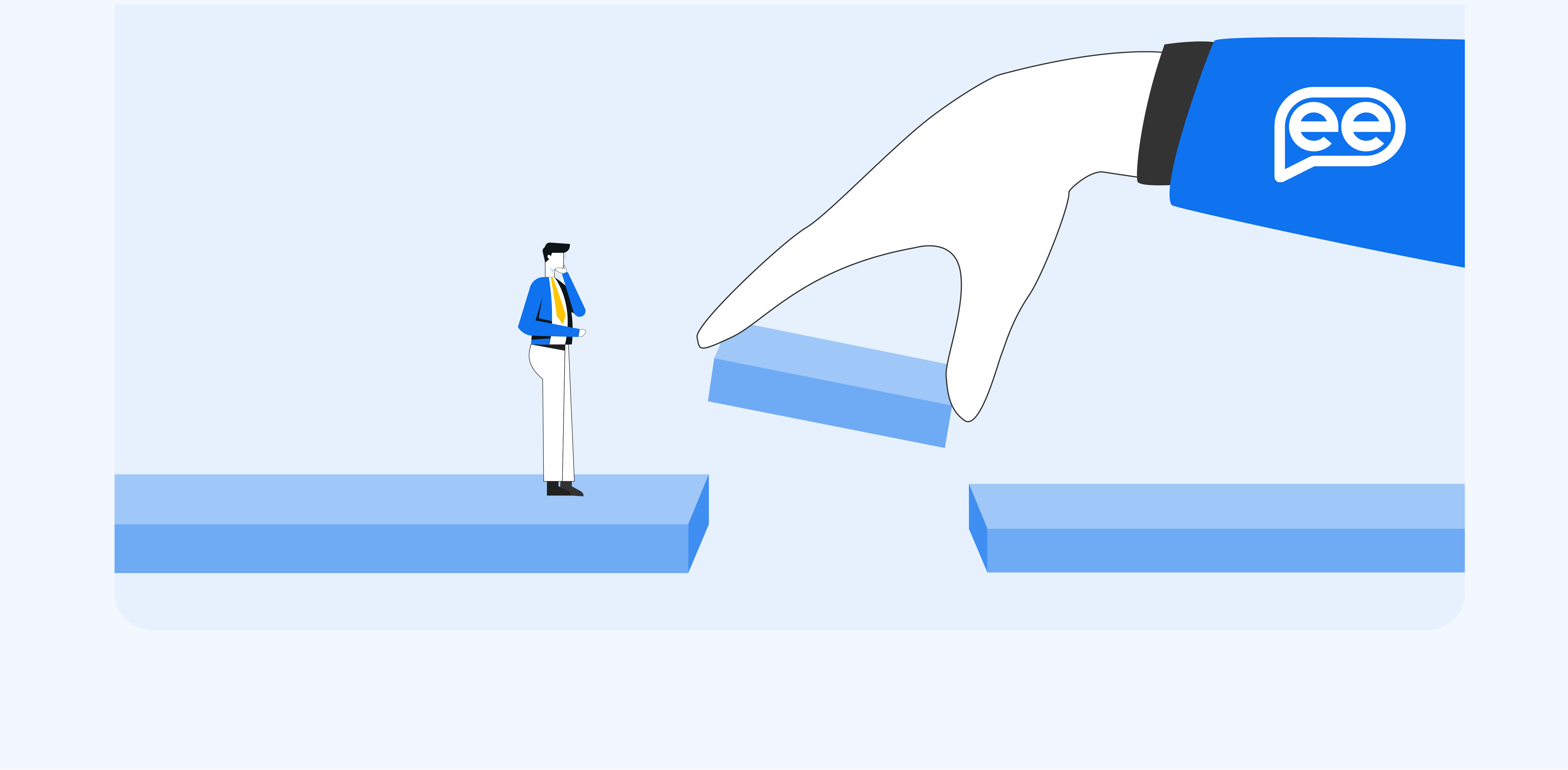Employee experience is an essential lever for success in any business. As 2023 reinforced the need for employee satisfaction and retention, organizations are willing to take proactive measures in 2024 to empower their bottom line and ensure a successful future.
Forbes has also mentioned that companies with high employee experience ratings have seen 3x higher employee productivity and 2x higher customer satisfaction.
The workplace of 2024 will be customer-centric, data-driven, and focused on employee well-being. Automation will be increasingly relied on for mundane tasks, allowing employees to focus on value-adding activities.
Employee experience trends such as the rise of remote work, employee well-being initiatives, digital transformation, and the implementation of AI will define employee experience in 2024.
By understanding and investing in these trends, companies can ensure that their employees remain engaged, productive, and satisfied. Here is a quick snapshot of the top employee experience trends we foresee emerging strongly in 2024.
Employee experience trends for 2024

Here are a few employee experience trends that are garnering momentum in 2024:
1. Better onboarding & enablement for new joiners
Many new onboards are usually all over the place when they join a company. They are left dependent on KTs and banal digital training modules for the first few weeks. This has been quite a trend, but as employee experience becomes a focus in the workplace, companies will need to improve onboarding and enablement for new employees to stay competitive in 2024.
Companies should create a comprehensive onboarding experience that addresses the basics of job tasks and help new hires acclimate to the new culture. The onboarding plan could include team-building activities, icebreakers, and meetings with key staff members.
Additionally, companies will need to provide a well-defined career path and training opportunities for new employees. These resources should be easily accessible and tailored to each individual.
Finally, companies must provide ongoing feedback and recognition to keep employees motivated and engaged. By investing in onboarding and enablement, companies can ensure that new employees have a positive experience, setting them up for success in the long term.
2. Grooming and up-leveling managers
Enabling managers with resources and skills will be a key employee experience trend for 2024.
The way managers engage with their team members has a significant impact on employee morale and productivity. Companies must invest in equipping managers with the necessary resources and skills to manage their teams effectively.
Here are a few things companies can do in 2024 for their managerial layer:
- Invest in targeted training programs for managers
- Provide managers with access to development tools
- Encourage managers to engage in mentorship programs
- Provide managers with the necessary resources to manage teams efficiently
- Create an environment that encourages collaboration between managers and employees
These practices can help companies to develop future leaders and foster a culture of innovation, allowing the company to stay competitive and ahead of the curve. As more and more companies recognize that effective management is essential for achieving their strategic goals, investing in the grooming and training of managers will only intensify in 2024.
3. Employee well-being will take center stage
Investing in employee well-being will become increasingly essential for employee experience in the coming years. As companies navigate the post-pandemic world, cultivating a work environment conducive to health and happiness has become the key.
Companies can take the following measures to ensure the well-being of their employees:
- Develop wellness initiatives: Companies should invest in physical and mental well-being initiatives for employees. These include health check-ups, healthy eating programs, mindfulness training, or flexible work arrangements.
- Promote a healthy work culture: Companies should promote a workplace culture that values employees’ mental and physical health. This can include offering wellness breaks, providing healthy snacks, and encouraging employees to take time off.
- Offer stress-reducing activities: Companies can conduct activities and programs that help employees manage stress. These can include yoga classes, massage therapies, or even game nights!
- Invest in employee development: Companies should invest in training and development programs that help employees grow and develop their skills. This can include job shadowing, mentorship programs, and even tuition reimbursement for professional upskilling programs.
- Foster an inclusive environment: Companies should ensure that their workplaces are inclusive and diverse. This can include offering diversity and inclusion training and creating a safe environment for everyone.
4. Skill mapping instead of slotting into traditional, restrictive roles
Employees worldwide now resist sticking to their traditional job roles. They want more horizontal breadth in their roles.
Skill mapping for employees is a process of tracking an organization’s current and future skill requirements and aligning them with the skills and abilities of the existing workforce. It is an integral part of a successful talent strategy as it helps identify workforce gaps, prioritize training initiatives and ensure that the organization is well-equipped to meet its goals.
Skill mapping can enable organizations to identify the skills and abilities of their workforce and ensure they align accurately with the business needs.
Here are five ways in which companies can take advantage of skill mapping to stay competitive in 2024:
- Identify skill gaps: Use skill mapping to identify gaps in employees’ skills and abilities and create targeted development plans to fill those gaps.
- Develop individualized training plans: Create individualized training plans for each employee based on their specific needs.
- Track employee progress: Ensure they meet the goals outlined in their development plans.
- Reward employees for achievements: Recognize and reward employees who have demonstrated mastery of a particular skill or set of skills.
- Enable career growth: Identify potential career paths and explore opportunities for growth within the organization.
5. The surge of people analytics
People analytics is a term used to describe the use of data to measure and analyze aspects of people management. It is a form of workforce analytics that uses data to help make informed decisions in areas such as recruitment, compensation, employee retention, and succession planning.
People analytics is becoming increasingly important and is expected to be a significant employee experience trend in 2024.
Companies who wish to stay ahead of the curve can leverage this trend in the following ways:
- Gather and study data to identify employee performance and satisfaction patterns and use them to inform decisions about organizational structure, policies, and strategies
- Use data to identify potential areas of improvement in the recruitment process
- Employ data to measure the impact of reward and recognition initiatives and re-design them as needed
- Analyze employee exit data to identify patterns in attrition and use this information to develop strategies for reducing staff turnover
- Utilize predictive analytics to identify potential issues before they arise and develop strategies to address them.
With the help of people analytics, companies will better understand their workforce, enabling them to make more informed decisions about employee experience and retention.
6. Technology-powered personalized workspaces
Technology-powered personalized workspaces have been gaining momentum consistently since 2015 and will only intensify in 2024. It combines technology and workspace design that enables companies to create an environment tailored to an individual’s preferences, needs, and work routines.
It focuses on creating a workspace conducive to productivity, engagement, and collaboration, both in-office and remote.
Companies can leverage this trend to facilitate both working in the office and collaborating while working from home in the following ways:
- Utilize HR analytics to identify user groups and craft personalized workspaces according to their needs
- Prioritize employee well-being by incorporating ergonomic furniture, natural light, and acoustic insulation
- Implement technology-driven solutions such as real-time collaboration tools and AI-driven analytics to simplify and streamline communication
- Incorporate hybrid workspaces that enable individuals to work from anywhere and anytime, with seamless access to resources and tools
- Design customizable workspaces that can adapt to accommodate changes in individual and team needs
In summary, a personalized workspace has numerous benefits for employees and employers. On the employee side, it can lead to greater comfort and productivity, as the tailored workspace will meet their individual needs and preferences. This is bound to lead to increased job satisfaction and morale and improved efficiency, leading to increased output and better results.
On the company side, a personalized workspace can help to reduce costs associated with employee turnover, as it helps to ensure employees are more satisfied and engaged in their work. Additionally, a personalized workspace can help to encourage collaboration and innovation, as employees are more likely to share ideas and work together more effectively.
7. It will no longer be just a job but a part of their identity
Employees today are seeking more than just a job. They want to be part of an organization that cares about their well-being and makes them feel valued.
Companies are responsible for creating an environment where employees are treated well and feel a sense of purpose. This can happen by humanizing work to give employees a greater understanding of meaning and satisfaction.
Here are some offbeat actions that almost all companies can take to humanize work:
- Encourage employees to take breaks and step away from their desks regularly
- Provide employees with fun activities and team-building events.
- Allow employees to show their personality in the workplace, either through dress code or decor
- Offer flexible work hours and schedules to give employees greater autonomy over their work
- Showing appreciation to employees through recognition and rewards
- Develop an open and transparent communication culture
- Fostering a collaborative and supportive workplace
- Promoting an open-door policy where employees feel comfortable speaking up and sharing their ideas
Employees today want to feel that their work has a purpose and that their efforts are appreciated. Companies must create a culture of trust and respect and ensure that employees feel valued and appreciated. This will help foster employee loyalty and commitment and, ultimately, lead to better performance and tremendous success.
It is time to lean on AI

Artificial intelligence has already become mainstream for organizations that want to improve their employees’ experience and provide them with 24*7 support.
Its capability to resolve employee queries automatically and provide them with high-touch support as and when required makes it a most sought-after solution among HRs.
The AI-powered virtual assistants empower HRs to focus on strategic business tasks while enabling employees to self-serve and resolve their queries.
Leena AI’s HR service delivery solution is a cutting-edge solution that improves employee experience across all touchpoints through personalized responses. HRs can automate different workflows, right from leave request approval to updating personal details, managing tax-related tasks, and payroll management. Its seamless integration capabilities ensure HRs get comprehensive visibility on a single platform.
If you want to know more about how the Leena AI platform works, book a free demo now!






